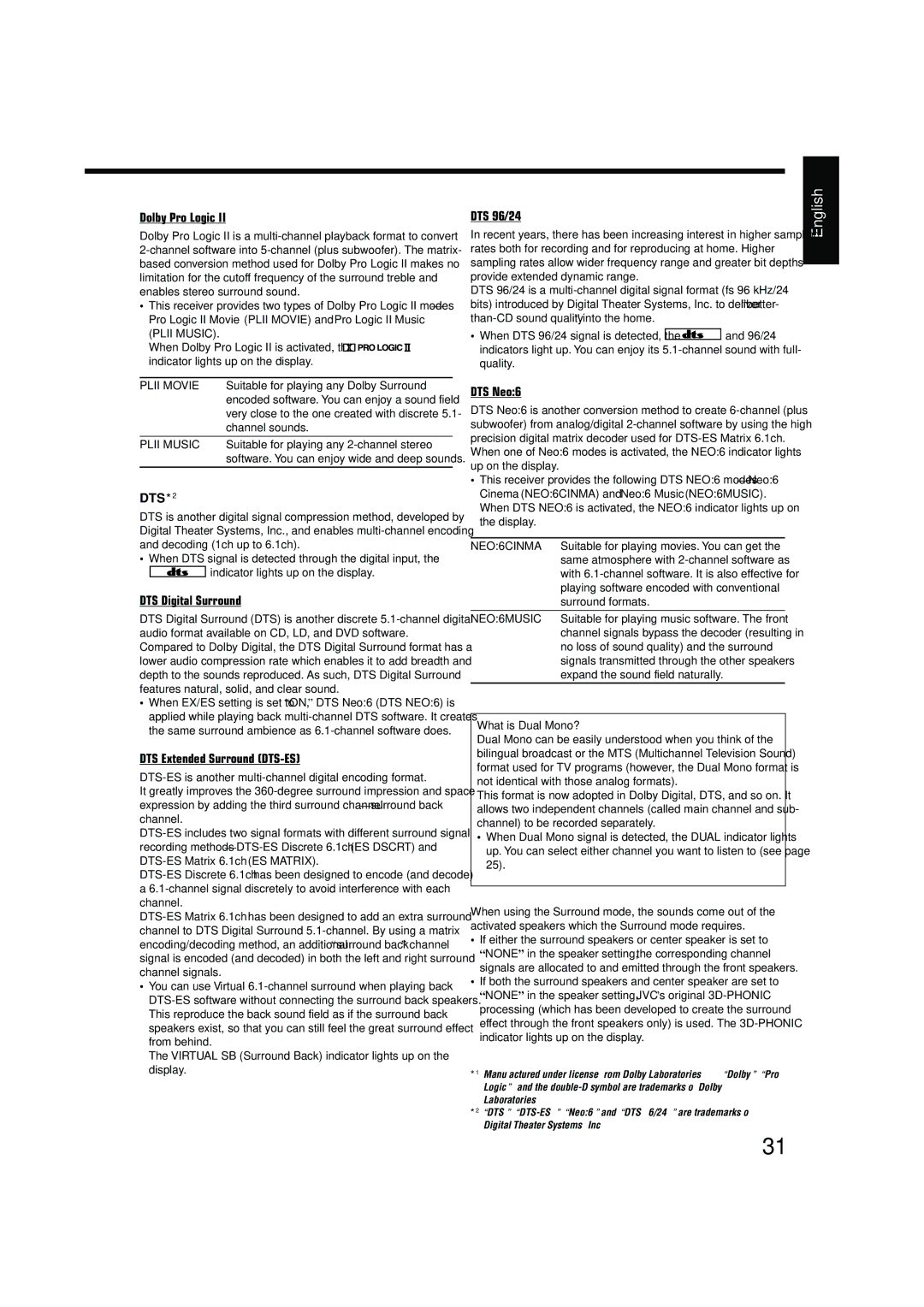
Dolby Pro Logic II
Dolby Pro Logic II is a
•This receiver provides two types of Dolby Pro Logic II modes— Pro Logic II Movie (PLII MOVIE) and Pro Logic II Music (PLII MUSIC).
When Dolby Pro Logic II is activated, the ![]()
![]()
![]()
![]()
![]()
![]()
![]()
![]() indicator lights up on the display.
indicator lights up on the display.
PLII MOVIE Suitable for playing any Dolby Surround encoded software. You can enjoy a sound field very close to the one created with discrete 5.1- channel sounds.
PLII MUSIC Suitable for playing any
DTS*2
DTS is another digital signal compression method, developed by Digital Theater Systems, Inc., and enables
•When DTS signal is detected through the digital input, the
indicator lights up on the display.
DTS Digital Surround
DTS Digital Surround (DTS) is another discrete
Compared to Dolby Digital, the DTS Digital Surround format has a lower audio compression rate which enables it to add breadth and depth to the sounds reproduced. As such, DTS Digital Surround features natural, solid, and clear sound.
•When EX/ES setting is set to “ON,” DTS Neo:6 (DTS NEO:6) is applied while playing back
DTS Extended Surround (DTS-ES)
It greatly improves the
•You can use Virtual
The VIRTUAL SB (Surround Back) indicator lights up on the display.
DTS 96/24
In recent years, there has been increasing interest in higher sampling rates both for recording and for reproducing at home. Higher sampling rates allow wider frequency range and greater bit depths provide extended dynamic range.
DTS 96/24 is a
•When DTS 96/24 signal is detected, the ![]() and 96/24 indicators light up. You can enjoy its
and 96/24 indicators light up. You can enjoy its
DTS Neo:6
DTS Neo:6 is another conversion method to create
•This receiver provides the following DTS NEO:6
NEO:6CINMA Suitable for playing movies. You can get the same atmosphere with
NEO:6MUSIC Suitable for playing music software. The front channel signals bypass the decoder (resulting in no loss of sound quality) and the surround signals transmitted through the other speakers expand the sound field naturally.
What is Dual Mono?
Dual Mono can be easily understood when you think of the bilingual broadcast or the MTS (Multichannel Television Sound) format used for TV programs (however, the Dual Mono format is not identical with those analog formats).
This format is now adopted in Dolby Digital, DTS, and so on. It allows two independent channels (called main channel and sub- channel) to be recorded separately.
•When Dual Mono signal is detected, the DUAL indicator lights up. You can select either channel you want to listen to (see page 25).
When using the Surround mode, the sounds come out of the activated speakers which the Surround mode requires.
•If either the surround speakers or center speaker is set to “NONE” in the speaker setting, the corresponding channel signals are allocated to and emitted through the front speakers.
•If both the surround speakers and center speaker are set to “NONE” in the speaker setting, JVC’s original
*1 Manufactured under license from Dolby Laboratories. “Dolby”, “Pro Logic”, and the
*2 “DTS”,
English
31
